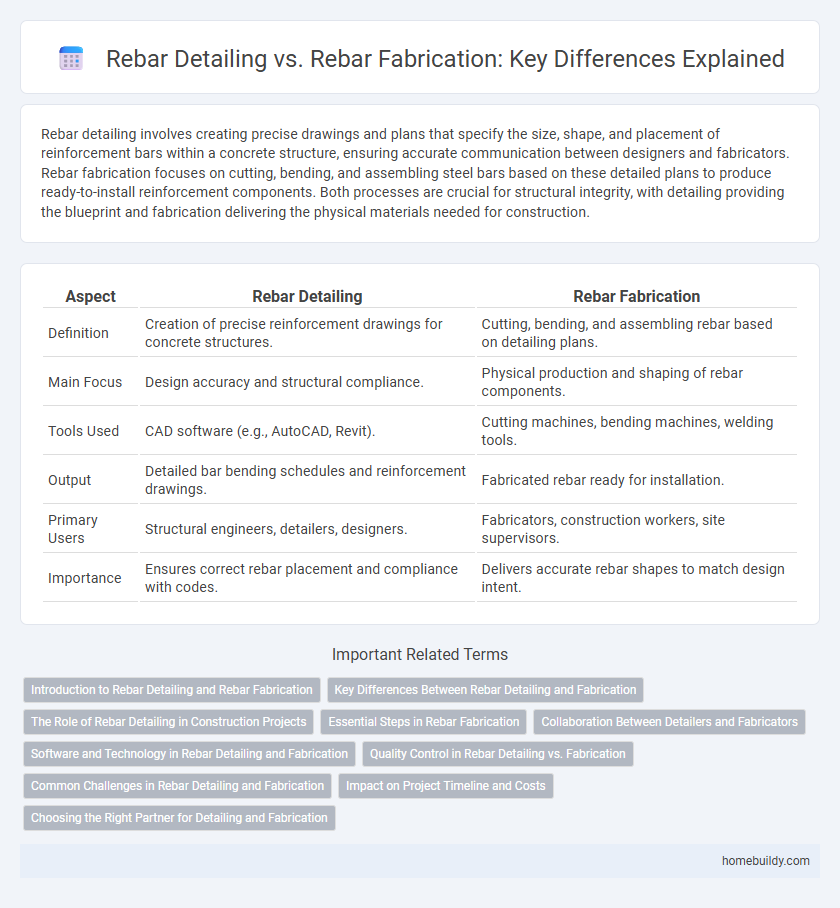Rebar detailing involves creating precise drawings and plans that specify the size, shape, and placement of reinforcement bars within a concrete structure, ensuring accurate communication between designers and fabricators. Rebar fabrication focuses on cutting, bending, and assembling steel bars based on these detailed plans to produce ready-to-install reinforcement components. Both processes are crucial for structural integrity, with detailing providing the blueprint and fabrication delivering the physical materials needed for construction.
Table of Comparison
| Aspect | Rebar Detailing | Rebar Fabrication |
|---|---|---|
| Definition | Creation of precise reinforcement drawings for concrete structures. | Cutting, bending, and assembling rebar based on detailing plans. |
| Main Focus | Design accuracy and structural compliance. | Physical production and shaping of rebar components. |
| Tools Used | CAD software (e.g., AutoCAD, Revit). | Cutting machines, bending machines, welding tools. |
| Output | Detailed bar bending schedules and reinforcement drawings. | Fabricated rebar ready for installation. |
| Primary Users | Structural engineers, detailers, designers. | Fabricators, construction workers, site supervisors. |
| Importance | Ensures correct rebar placement and compliance with codes. | Delivers accurate rebar shapes to match design intent. |
Introduction to Rebar Detailing and Rebar Fabrication
Rebar detailing involves creating precise drawings and plans that specify the size, placement, and bending shapes of reinforcing bars in construction projects. Rebar fabrication refers to the actual cutting, bending, and shaping of steel bars according to the detailed drawings before delivering them to the construction site. Together, these processes ensure structural integrity and efficient assembly of reinforced concrete components.
Key Differences Between Rebar Detailing and Fabrication
Rebar detailing involves creating precise drawings and plans that specify the size, shape, location, and quantity of reinforcement bars for construction projects, ensuring accurate implementation on-site. Rebar fabrication refers to the physical process of cutting, bending, and assembling the steel reinforcement bars according to the detailed drawings to meet project specifications. Key differences lie in detailing being a design and planning phase focused on technical documentation, while fabrication is a manufacturing phase centered on transforming steel materials into ready-to-install components.
The Role of Rebar Detailing in Construction Projects
Rebar detailing is a critical process in construction projects that involves creating precise drawings and schedules specifying the size, shape, and placement of reinforcing bars to ensure structural integrity and compliance with design specifications. It bridges the gap between engineering design and rebar fabrication by providing accurate information needed for cutting, bending, and assembling reinforcement efficiently. Effective rebar detailing minimizes errors, reduces material waste, and streamlines on-site installation, ultimately enhancing project productivity and safety.
Essential Steps in Rebar Fabrication
Rebar fabrication involves critical steps such as cutting, bending, and assembling steel bars to precise specifications based on structural design requirements. Accurate measurement and detailed drawings from rebar detailing guide the fabrication process to ensure proper strength and durability. Quality control checks during each fabrication stage are essential to maintain compliance with industry standards and project specifications.
Collaboration Between Detailers and Fabricators
Effective collaboration between rebar detailers and fabricators ensures precise communication of design specifications and accurate production of reinforcement components. Utilizing Building Information Modeling (BIM) and 3D modeling tools enhances coordination, minimizes errors, and streamlines workflow from detailing to fabrication. A seamless data exchange through compatible software platforms fosters improved project efficiency, reducing delays and costly rework in construction.
Software and Technology in Rebar Detailing and Fabrication
Rebar detailing relies heavily on specialized software such as AutoCAD Rebar, Revit, and Tekla Structures to create precise 3D models and detailed shop drawings that ensure accurate bending and placement instructions. Rebar fabrication integrates CNC bending machines and automated cutting technologies driven by software outputs from detailing programs, enhancing efficiency and reducing human error. Advanced BIM (Building Information Modeling) platforms facilitate seamless data transfer between detailing and fabrication stages, streamlining project workflows and improving overall structural integrity.
Quality Control in Rebar Detailing vs. Fabrication
Quality control in rebar detailing ensures accurate interpretation of structural drawings, minimizing errors before fabrication begins, which saves time and reduces material wastage. In rebar fabrication, quality control focuses on precise cutting, bending, and welding according to detailed specifications, guaranteeing structural integrity and compliance with safety standards. Both stages require rigorous inspection protocols to maintain overall construction quality and prevent costly rework.
Common Challenges in Rebar Detailing and Fabrication
Rebar detailing often faces challenges such as maintaining dimensional accuracy, interpreting complex structural designs, and ensuring clear communication between engineers and fabricators. In rebar fabrication, common issues include managing material wastage, adhering to tight tolerances during cutting and bending, and coordinating logistics for timely delivery to construction sites. Both processes require precise coordination to minimize errors, reduce rework, and optimize construction timelines.
Impact on Project Timeline and Costs
Rebar detailing provides precise construction drawings that streamline the fabrication and installation process, reducing errors and rework, which shortens project timelines and lowers overall costs. Efficient rebar fabrication ensures accurate cutting, bending, and assembly of reinforcement bars, minimizing material waste and labor expenses. Coordinated detailing and fabrication together enhance project efficiency, leading to significant cost savings and timely completion.
Choosing the Right Partner for Detailing and Fabrication
Selecting the right partner for rebar detailing and fabrication ensures precision and efficiency in construction projects, minimizing errors and costly delays. Expert rebar detailing provides accurate placement plans crucial for structural integrity, while skilled fabrication produces components adhering to stringent quality standards. Collaborating with a partner experienced in both detailing and fabrication streamlines workflows, enhances coordination, and delivers reliable reinforcement solutions.
Rebar Detailing vs Rebar Fabrication Infographic

 homebuildy.com
homebuildy.com